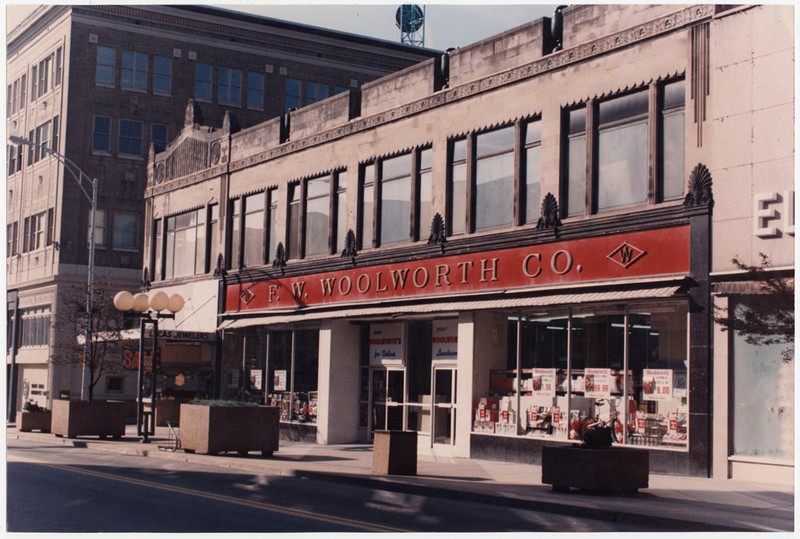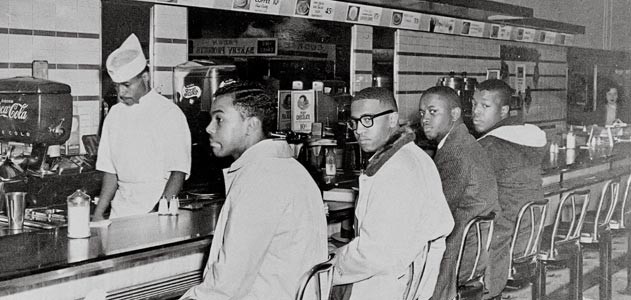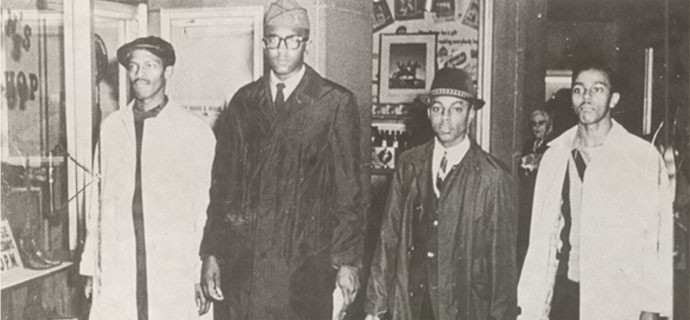Greensboro Sit-Ins and the International Civil Rights Center and Museum
Introduction
Text-to-speech Audio
Images
The old Woolworth's building is now home to a civil rights museum

The original lunch counter and stools where the four students sat on Feb. 1, 1960, has never been moved.


A&T Four, photographed by Jack Moebes on February 1, 1960, as they left the Woolworth that day. From left to right, David Richmond, Franklin McCain, Ezell Blair, Jr., and Joseph McNeil.

Backstory and Context
Text-to-speech Audio
On February 1, 1960, four Black students from North Carolina Agricultural and Technical College (NCA&T) organized a "sit-in" that would soon rapidly spread throughout the South. At the Woolworth Store in Greensboro, North Carolina, Franklin McCain, Joseph McNeil, Ezell Blair Jr., and David Richmond, performed a “sit-in” demonstration, where the students sat at the “whites only” lunch counter. These students were denied service but stayed until the store closed.
By the next day (Feb. 2nd), twenty NCA&T students followed in the footsteps of the “Greensboro Four” by conducting a sit-in at the same Woolworth store in downtown Greensboro. By the third day, over three hundred students participated in the sit-in movement at, again, the same Woolworth store in Greensboro. Within the span of a week, the actions of the “Greensboro Four” started a wave of sit-in demonstrations and protests in Durham, Greensboro, and Raleigh. Local residents met many of these protestors and sit-in participants with hostility. Eventually, the Greensboro Woolworth store was forced to close its lunch counters.
The actions by the four Black students in Greensboro led to the formation of the influential Civil Rights organization known as the Student Non-violent Coordinating Committee. Students at Shaw University founded “SNCC” in April, 1960. SNCC’s purpose was to train peaceful protesters and organize non-violent demonstrations that would target the segregation laws of Jim Crow. The sit-in movement, along with the help of SNCC, spread throughout the South in 1960, which was mainly in the form of "sit-in" at lunch counters. By the end of 1960, sit-in demonstrations occurred in seventy-eight towns and cities. Over fifty thousand students participated in the protests and over three thousand students were arrested. By July 26th, 1960, every Woolworth store became desegregated by order of the company themselves.
The old Woolworth's is now home to the International Civil Rights Center & Museum. The museum preserves the site of the February 1 sit-in and offers exhibits and archives that explain how it served as a catalyst for the direct-action protests in Greensboro and other cities. The museum’s traveling exhibits have in the past included “And Still I Rise”, “A Celebration of Progress”, and “Dr. King and the March on Washington”. The “And Still I Rise” exhibit, named after the poem “Still I Rise” by Maya Angelou, showcases famous artists and athletes who overcame racial barriers and excelled in their field.
Melvin “Skip” Alston and Earl F. Jones founded the museum. Alston was the first African-American Chairman of the Guilford County commissioner’s board. He was first elected to this position in 2003 and was reelected in 2009. He is an active member of the Guilford County Elected Officials Black Caucus, the North Carolina Association of Black Officials, and the NAACP. Jones represented District 60 in the North Carolina State Legislature from 2002-2011. He was also in charge of Greensboro’s anti-poverty program for 20 years and provided legal counsel for the NAACP.
Sources
Chafe, William. Civilities and Civil Rights: Greensboro, North Carolina, and the Black Struggle for Freedom. Oxford: Oxford University Press, 1980.
Iwan Morgan and Philip Davies, From Sit-Ins to SNCC: The Student Civil Rights Movement in the 1960s (Gainesville, FL: Florida University Press, 2012), 1-21.
"A&T Students Launch 'Sit-Down' Demand for Service at Downtown Lunch Counter," February 2, 1960. Greensboro Record. UNCG North Carolina Collection.
"Is This Right?" February 2, 1960. Greensboro Daily News.
